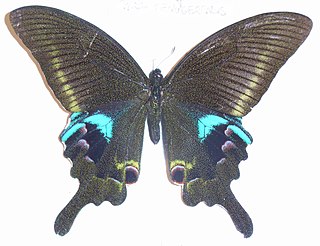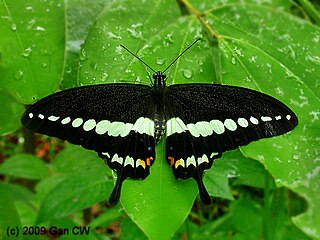
Papilio helenus, the red Helen, is a large swallowtail butterfly found in forests of southern India and parts of southeast Asia.

Graphium nomius, the spot swordtail, is a butterfly found in South and Southeast Asia that belongs to the swallowtail family. The species was first described by Eugenius Johann Christoph Esper in 1793. One of the grandest sights is a host of spot swordtails mud-puddling or swarming around a flowering forest tree.

Papilio paris, the Paris peacock(Myanmar name: ဒေါင်းစိမ်းလိပ်ပြာ), is a species of swallowtail butterfly found in the Indian subcontinent and southeast Asia.

Papilio alcmenor, the redbreast, is a species of swallowtail butterfly found in South Asia.

Papilio crino, the common banded peacock, is a species of swallowtail (Papilionidae) butterfly found in parts of the Indian subcontinent, including India, Nepal, Bhutan and Sri Lanka.

Papilio arcturus, the blue peacock, is a species of swallowtail butterfly found in the Indian subcontinent.

Papilio bootes, the tailed redbreast, is a swallowtail butterfly found in Asia. Within their wide distribution about four population variants have been named as subspecies. They have been placed within the Menelaides clade by a 2015 phylogenetics study.

Papilio castor, the common raven, is a species of swallowtail butterfly found in Cambodia and South Asia.

Papilio elephenor, the yellow-crested spangle, is a species of swallowtail butterfly found in Northeast India. Following decades without confirmed sightings, it was rediscovered in 2009 in Assam.

Papilio krishna, the Krishna peacock, is a large swallowtail butterfly found in forests in China, Nepal, north east India, Myanmar and Vietnam.

Papilio nephelus is a species of swallowtail butterfly belonging to the family Papilionidae. Subspecies include P. n. chaon, the yellow Helen, and P. n. sunatus, the black and white Helen.

Papilio protenor, the spangle, is a butterfly found in India belonging to the swallowtail family.

Papilio buddha, the Malabar banded peacock, is a species of swallowtail butterfly found in the Western Ghats of India. The Government of Kerala declared it as the official Kerala state butterfly.

Teinopalpus imperialis, the Kaisar-i-Hind, is a rare species of swallowtail butterfly found from Nepal and north India east to north Vietnam. The common name literally means "emperor of India". The Kaisar-i-Hind is much sought after by butterfly collectors for its beauty and rarity. The green iridescence of the wings has been found to be due to three-dimensional photonic structure of the scales and is the subject of much research.

Losaria rhodifer, the Andaman clubtail, is a rare species of the swallowtail family, Papilionidae, native to India. The butterfly belongs to the genus Losaria, or the clubtails, as they are commonly known.

Papilio clytia, the common mime, is a swallowtail butterfly found in south and southeast Asia. The butterfly belongs to the subgenus Chilasa, the black-bodied swallowtails. It serves as an excellent example of a Batesian mimic among the Indian butterflies.

Papilio (Chilasa) slateri, the blue striped mime, is a swallowtail butterfly found across south and south-east Asia. The butterfly belongs to the mime subgenus, Chilasa, of the genus Papilio, the black-bodied swallowtails. The nominate subspecies is found in India and is also called the brown mime. It is a good example of mimicry among Indian butterflies.

Papilio mayo, the Andaman Mormon, is a species of swallowtail butterfly that is endemic to the Andamans in the Bay of Bengal. It is a species that is protected by Indian Law. The scientific name honours Richard Bourke, 6th Earl of Mayo, who was assassinated at Port Blair the year before the butterfly was discovered.

Cepora nadina, the lesser gull, is a small to medium-sized butterfly of the family Pieridae, that is, the yellows and whites. The species was first described by Hippolyte Lucas in 1852. It is native to Sri Lanka, India, Myanmar, Hainan, and southeast Asia.

Papilio demolion, the banded swallowtail, is a species of swallowtail butterfly belonging to the family Papilionidae.




















